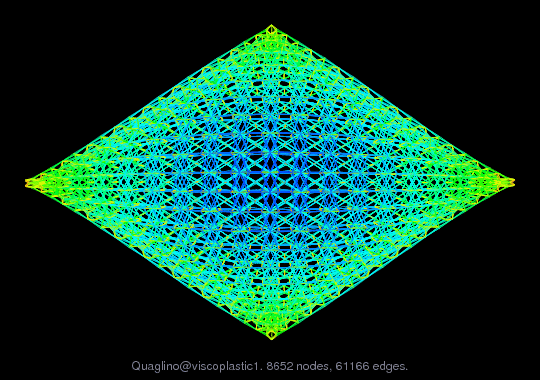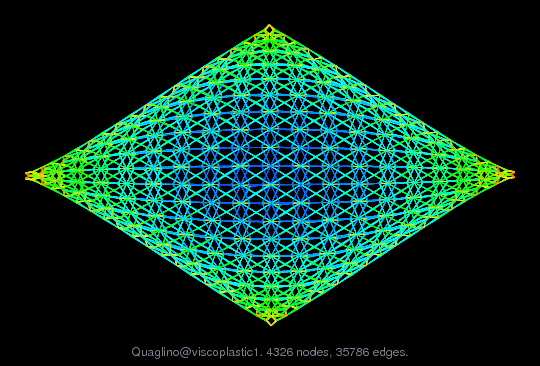

Matrix: Quaglino/viscoplastic1
Description: FEM discretization of a viscoplastic collision problem, Alessio Quaglino
 |
 |
| (bipartite graph drawing) | (graph drawing of A+A') |
 |
| Matrix properties | |
| number of rows | 4,326 |
| number of columns | 4,326 |
| nonzeros | 61,166 |
| structural full rank? | yes |
| structural rank | 4,326 |
| # of blocks from dmperm | 1 |
| # strongly connected comp. | 1 |
| explicit zero entries | 0 |
| nonzero pattern symmetry | 74% |
| numeric value symmetry | 0% |
| type | real |
| structure | unsymmetric |
| Cholesky candidate? | no |
| positive definite? | no |
| author | A. Quaglino |
| editor | T. Davis |
| date | 2007 |
| kind | materials problem |
| 2D/3D problem? | yes |
| Additional fields | size and type |
| b | full 4326-by-1 |
| C | cell 7-by-1 |
Notes:
The matrix is in the form [A11 A12 ; A21 A22] where A11 and A22 are diagonal.
Originally, the matrices in this set were poorly scaled, but this was resolved
by a scale factor of the form [A11 A12*e ; A21/e A4] where the scalar e is
of magnitude 1e2 but can be 1e6 or 1e7 for a stiff material. The Problem.A
matrix is the properly scaled problem. The Problem.aux.C{1:7} matrices have
been "unscaled" with a factor e = 10.^(-(1:7)), to give a sequence of matrices
that are well scaled to poorly scaled, and thus well conditioned (C{1}) to
poorly conditioned (C{7}). This mimics the original poorly scaled and ill-
conditioned problem, and may be of interest for those developing algorithms
for automatic scaling. From a FEM discretization of a viscoplastic collision
problem, Alessio Quaglino.
| Ordering statistics: | result |
| nnz(chol(P*(A+A'+s*I)*P')) with AMD | 71,771 |
| Cholesky flop count | 2.2e+06 |
| nnz(L+U), no partial pivoting, with AMD | 139,216 |
| nnz(V) for QR, upper bound nnz(L) for LU, with COLAMD | 705,015 |
| nnz(R) for QR, upper bound nnz(U) for LU, with COLAMD | 1,530,390 |
| SVD-based statistics: | |
| norm(A) | 73.8743 |
| min(svd(A)) | 0.000529054 |
| cond(A) | 139635 |
| rank(A) | 4,326 |
| sprank(A)-rank(A) | 0 |
| null space dimension | 0 |
| full numerical rank? | yes |
| singular values (MAT file): | click here |
| SVD method used: | s = piro_band_svd (A) |
| status: | ok |

For a description of the statistics displayed above, click here.
Maintained by Tim Davis, last updated 12-Mar-2014.
Matrix pictures by cspy, a MATLAB function in the CSparse package.
Matrix graphs by Yifan Hu, AT&T Labs Visualization Group.